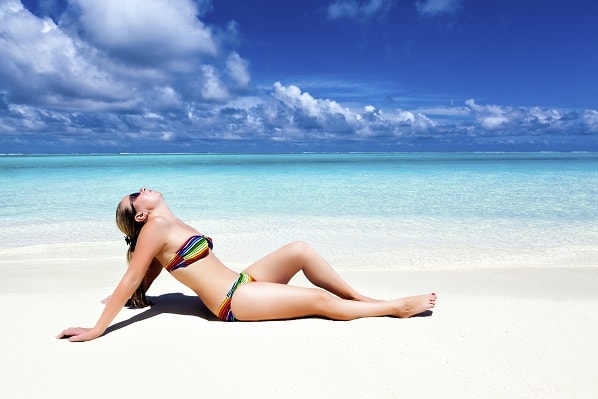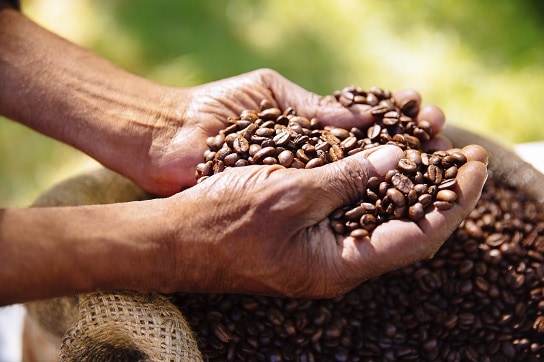 Perhaps the biggest tightrope an acne patient must walk in the quest for clear skin is the fateful balance of sunlight.
Perhaps the biggest tightrope an acne patient must walk in the quest for clear skin is the fateful balance of sunlight.
Sunlight is vital for vitamin D, blood flow, glow and killing bacteria, but it can also redden, inflame and generate swarms of free radicals. Then there’s a more basic problem: you don’t want to be starved of fun, a recluse who can’t even walk outside without transforming into his pizza-face alter ego.
The key to acquiring sunlight’s benefits is to strengthen your skin against its dangers. Today, many people lack the important vitamins and antioxidants and are weaker than they should be…
…but today’s sunshine secret is one which has long hid under our noses. You don’t have to take pharmaceutical drugs. You don’t have to apply greasy, reddening moisturisers. You don’t have to lie on an operating table while a maniacal scientist fires an experimental laser cannon into your face.
No, our secret is coffee, and all you have to do is drink it.
Proven in ever more studies
As of 2020, the debate over coffee’s health benefits continues in its endless tug of war.
It’s the classic case where a newspaper screams that “coffee cures cancer”, only to warn ominously of “coffee heart dangers” just 3 days later, with a short term memory even a housefly would smirk at. The average person is left bewildered, and this is just as true for acne as it is for overall health.
The internet is full of horror breakout stories but also promising tales of antioxidants. Nobody can agree; it’s the opposite of antibiotics where every acne player slowly turned against them.
So here’s the good news – coffee can be great for acne. Like dark chocolate, it’s one of the greatest acne-friendly treats around. The only significant problem is caffeine cranking up your stress hormones, and now, there’s another excellent reason to keep drinking it.
ONE: in 2014, dietary questionnaires were gathered on 390 controls and 377 basal cell carcinoma (BCC) patients. The highest category of caffeine consumption had a 43% lower caffeine risk of BCC compared to people who drank none. Both caffeine and hot tea reduced the risk of skin cancer. Their verdict was a “modest protective effect” which “may, in part, be due to caffeine“.
TWO: in 25474 skin cancer patients, both caffeinated coffee and overall dietary caffeine were strongly protective against basal cell carcinoma. That goes for tea, chocolate and even coca-cola. As for decaf coffee? There were no benefits. Women who drank coffee daily were vastly more protected compared to once monthly (2012 study).
That said, caffeine also had no effect on SCCs or melanoma. Essentially, basal cell carcinoma (BCC) is the gentlest skin cancer. It affects 4 million American every year, grows slowly, and rarely spreads to the rest of the body. Squamous cell carcinoma kills 15,000 Americans yearly, and has a 5% chance of spreading. Malignant melanoma is the supervillain, fast growing, fast spreading and killing the most people.
THREE: using three long term population surveys, scientists studied 166,886 women and 39,424 men. This time, caffeine protected against malignant melanoma, particularly in women. The highest coffee consumption category had a 22% smaller risk than the lowest. Decaf coffee had no benefits (2015 study). A telling sign was that in the torso, which is rarely exposed to the sun, the benefits for skin cancer vanished.
FOUR: 305 controls and 304 skin cancer patients were tested in Italian hospitals. Coffee drinking was strongly protective against cutaneous melanoma, in patients drinking coffee more than once daily versus less than once daily (2013 study).
FIVE: scientists dug up archive data on 25,708 Norwegian men and 25,049 Norwegian women from 1977 to 1983. They were aged between 16-56, and their dietary habits were gathered using questionnaires. Cod liver oil and polysunsaturated fats increased the risk of cutaneous malignant melanoma, but coffee drinking decreased it. All three differences applied to women, but not men (1007 study).
SIX: in August 2011, this mouse study charged its way onto newspaper headlines worldwide. I don’t know why this one created such an earthquake, as it mostly delves into molecular science, whereas other studies tested real life coffee drinkers.
But anyway, isolated caffeine was tested, rather than whole coffee. In mouse skin cells, caffeine successfully inhibited ATR, a molecule which prevents malignant cancer cells from undergoing apoptosis, AKA programmed cell death.
In other words: caffeine encourages cancer to self destruct, as it politely should. Separately, they gathered some mice with genetic ATR deficiencies, and when exposed to sunlight, they remained tumour free for far longer, showing a clear link. This, this and this study detected the same ATR alterations from caffeine.
SEVEN: perhaps the greatest study. Its scale was vast, including 447,357 Hispanics who filled in a Food Frequency Questionnaire over many years, with 2904 eventually developing malignant melanoma. The conclusion: “higher coffee intake was associated with a modest decrease in risk of melanoma“. Compared to non-drinkers, the most coffee obsessed people had a 20% smaller risk. In a familiar theme, decaffeinated coffee had no benefit.
An ancient secret (possibly)
The simple act of drinking coffee, done by millions of office workers and revising students, can supercharge your skin’s sunlight defences.
The evidence isn’t 100% infallible, but it’s steadily inching closer. The chain of the theory has no holes in it. Like beta-carotene in carrots or lycopene in tomatoes, caffeine is known to accumulate in the skin. About 1/6 is absorbed by the stomach, while the rest is absorbed thorough the small intestine.
Bloodstream levels peak between 1-2 hours after drinking a mug. Most importantly, caffeine is distributed to every water-containing tissue of your body. Caffeine can even cross the brain-blood barrier, which is how it alters neurotransmitters like acetylcholine and adenosine, so reaching the skin is no biggie.
What about acne from sunlight?
 The real question is whether these tumour-suppressing benefits translate to clear skin. Luckily, we have studies on inflammation too.
The real question is whether these tumour-suppressing benefits translate to clear skin. Luckily, we have studies on inflammation too.
This one cut right to the chase and examined NF-kappaB, the dark and twisted genetic master molecule of inflammation which controls smaller chemicals like TNF-a and IL-6. In malignant melanoma cells, splashing coffee over someone’s face (OK, maybe it was more subtle than that) blocked two molecules called ATM and PKC which usually increase NF-kappa-B in response to sunlight. Supposedly, “caffeine is a potent inhibitor of UV-induced NF-kappaB activation“.
The mere fact that tumours are proven is automatically a promising (if not proven) sign. For example, COX-2 is confirmed to be abundant in malignant melanoma tumours (study). COX-2 is a powerful inflammatory chemical targeted by painkillers. UV exposure can directly increase COX-2 levels (study), while this study found higher than average COX-2 levels in acne. Then there’s free radicals, expert disruptors of DNA, but also acne-causing villains.
ATR and apoptosis probably won’t impact acne, but the smart guess is that coffee will dampen inflammation from sunlight at the very least.
Caffeic acid – caffeine’s sidekick
We also have second compound, a bit part player. It’s caffeic acid, a phytonutrient distributed widely in nature, but most abundantly in coffee, alongside the structurally related chlorogenic acid.
Scientists tested both compounds on isolated mouse skin cells (study), and caffeic acid strongly blunted the COX-2 increase from UV radiation. Generally, it’s known that sunlight stimulates COX-2 by activating proteins in the skin called Kyn kinases. Well, caffeic acid bound to Kyn kinase at a molecular level and blunted this response, cutting a chain in the inflammatory connection. COX-2 also fell when caffeic acid was applied to living, breathing mice in the sun.
In every test, caffeic acid was noticeably superior. Normally in studies, chlorogenic acid reigns supreme, the prince of heart health and anti-inflammatory properties. They concluded that “this compound could act as a potent chemopreventive agent against skin cancer“.
The future looks bright for caffeic acid, but is it really a secondary sun shield? Firstly, there’s some doubt about the coffee bean’s content of it. A figure floating around the vast disembodied world of internet cyberspace states that filtered coffee contains just 0.03mg per 100ml. That’s useless compared to potatoes with 1.62mg and sunflower seeds with 8.17mg.
After investigation, I believe that this figure is wrong, because the study above states that the average coffee drinker imbibes 250-500mg per day. This study found that a 100 gram cup contained 195.7mg of caffeic acid, 4.265 grams of caffeine, and 3.893 grams of chlorogenic acid.
It seems that caffeic acid exists in both free and bound forms. So that’s no problem, but the real flaw is all those studies showing that decaf coffee didn’t work.
Decaffeinated coffee wasn’t tested in every study. It’s possible too that decaf had minor benefits, but they didn’t reach statistical significance.
Decaf is also lower in antioxidants overall, because of both processing techniques and poorer quality cast-off beans. Perhaps caffeic acid is particularly vulnerable to decaffeination. However, that theory is debunked by the study above; decaf coffee averaged at more caffeic acid, with 223.3mg per 100mg.
Nevertheless, caffeic acid probably adds a nice bonus to the sun shield.
Why some people may particularly benefit
 You’ve probably heard of the antioxidant glutathione, which also functions as a detoxification agent in the form of glutathione-s-transferase (GST). There’s 8 forms of GST, including alpha and delta. Each have different toxins under their jurisdiction, and two special genes called GSTM1 and GSTT1 create the Mu and Theta forms respectively.
You’ve probably heard of the antioxidant glutathione, which also functions as a detoxification agent in the form of glutathione-s-transferase (GST). There’s 8 forms of GST, including alpha and delta. Each have different toxins under their jurisdiction, and two special genes called GSTM1 and GSTT1 create the Mu and Theta forms respectively.
In the Italian hospital study (number 4), people lacking those genes, which is quite common, enjoyed dramatically more skin cancer protection from coffee.
It’s an interesting result for us, because deficiencies in GST aren’t just caused by genes. Diet is another factor, just like for glutathione’s antioxidant form (see here). You might be glutathione deficient, your boss might be glutathione deficient; even your mailman might be glutathione deficient.
Because GST digests toxins, a deficiency can make you more susceptible to cancer. Simultaneously, GST deficiencies can make some pharmaceutical drugs more effective because they linger in the bloodstream for longer. Therefore, the scientists theorised that this was happening with caffeine.
I have a simpler theory though. Because more toxins were rampaging through the bloodstream without being detoxified, more antioxidants were probably being depleted too. Because antioxidants have UV-protecting powers, whether it’s vitamin C or lutein, the carriers of the unfortunate genes probably had more room to improve.
Therefore, if your skin is free radical headquarters, coffee might be particularly great.
Maybe your city is polluted, maybe you sit on the underground with a heavy-coated guy blowing cigarette smoke in your face, or maybe you cannot afford organic strawberries.
Another repeated result was that women benefited more. We could argue about genetics, hormones and collagen till the cows come home, but as the scientists in study three stated, it’s probably because women expose more of their bodies to the sun and have more room to gain.
Random theories
If caffeine physically accumulates in your skin then common sense states that UV protection won’t be the only consequence. There could be negative ones, but one might be antibacterial powers.
Why? Because in studies dating back to 1980, caffeine ruthlessly suppresses the growth of toxic moulds like aspergillus ochraceus. In one study, caffeine completely disabled aspergillus moulds after 21 days. Caffeine totally deactivates the energy transporters which shift glucose through the cell membrane and into the mould’s core. Aspergillus moulds pump out mycotoxins and this is the main reason why decaf coffee is considered “dirtier” than a normal mug (see here).
The connection to acne? You guessed it – caffeine might starve p.acnes bacteria of nutrients too. It’s highly unlikely, because p.acnes’ energy-grabbing methods are totally different. Rather than glucose, p.acnes releases lipases which break down sebum (oil) to obtain glycerol. Plus, moulds and bacteria are very different.
Still, you never know. Suppressing infectious moulds is caffeine’s main role in the coffee bean plant (not to keep stockbrokers up all night). Speaking of which, it’s possible that UV protection is a natural power too, as plants like tomatoes naturally produce antioxidants to defend themselves. Some arguments against are that the coffee bean exists under shady forest canopies and that altering ATR, NFKappaB and apoptosis are only really relevant to human skin. Beta-carotene in carrots physically absorbs UV light, and consequently works in both animals and plants (PS: carrots are another potential sunscreen food).
Analysis – a real power or stuck in study land?
 Now that we’ve dealt with the science, can an acne patient actually use this information? The answer is yes, but firstly, you should not start drinking more caffeine if you have a sensitivity.
Now that we’ve dealt with the science, can an acne patient actually use this information? The answer is yes, but firstly, you should not start drinking more caffeine if you have a sensitivity.
The sunshine protection powers will not override random acne outbreaks. Great as the studies are, it’s not worth the risk when carrots, dark chocolate and tomatoes can also block UV light. This is also true if you’re stressed, because coffee spikes cortisol levels.
Secondly, drinking coffee will never be a miracle cure. Coffee will never make your skin so UV resistant that you can tap dance on the sun’s surface on a Friday night.
Even within natural sun nutrition, beta-carotene is much more important, the plant-based precursor to vitamin A. So are vitamin E and other carotenoids like lutein and zeaxanthin. They’re the bread and butter, the foundation of the nutrition we need; caffeine is a random phytochemical halfway across the world which happens to be great.
The good news is that coffee is an excellent bonus strategy, a way to move up another 1000 spots in the sun-resistant world rankings.
The deluge of great studies cannot be denied. 10 years ago, we would have been far more cautious, but the balance of evidence has now tipped off the scale.
Caffeine’s pathways like ATR and apoptosis are very distinct, and stand independently of other foods. For example, if you already eat loads of antioxidants, then adding more probably won’t increase your sun protection, but caffeine will, because it works through a different mechanism.
Now here’s the disclaimer: this article is entertainment, not medical advice, and you should always follow the sun exposure advice of official governmental health bodies.
Before we storm the jungles of South America, there’s one final flaw: acne itself. I’m still not convinced that the tumour suppressing properties will translate, because they’re so specialised.
Some plant remedies like turmeric aren’t 100% proven either, but calm overall bodily inflammation so strongly that it’s an easy step to clear skin. Not so here.
However, basic sun protection would be great itself, because it still opens up sunlight’s acne benefits. There’s vitamin D, there’s endorphin release, there’s antibacterial properties, and there’s improved blood flow due to nitric oxide (see the roadmap veins on your forearm).
What you must do
What if you’re already a coffee drinker – should you gulp down more and more? The studies above say that coffee’s benefits were dose dependent.
Caffeine isn’t like vitamin D and magnesium where extra benefits stop beyond a certain point; it’s like vitamin C with its 1000mg megadoses. That said, I definitely don’t recommend 10 cups daily because your stress hormones will still skyrocket. If you drink one cup daily, your skin will get stronger by adding another.
The wider strategical benefit is keeping one of your favourite treats in place. With pizza, burgers and chocolate cake mostly exiled, the ever-evolving greatness of coffee will make discipline much easier. Better yet, you might have another treat in store. Once you’re slashed your sugar intake, savoury foods will suddenly taste dramatically better. Your taste buds will reactivate. No longer muffled by sugar, the complex flavours of plant foods will come rushing back. Try eating steak after sugar binge; it’s like dining on a high heel shoe.
PS: there’s no need to eliminate sugar entirely. Your skin will withstand milk chocolate, fruit yoghurt, and a sprinkling in coffee in moderation.
Conclusion
The saga of coffee and acne continues, and is moving in exactly the direction we hoped.
Here’s the concise verdict: drinking coffee is a great hidden strategy for moderately boosting your skin’s sunlight defences. If you’re a coffee fanatic, but also suffer from acne, then the good news continues to pour in.
Thanks for reading!
Would caffeine pills have the same benefits as coffee?
Yes, but coffee would be better because of all the other hidden compounds inside it. We still don’t understand 100% of how it works, but at the same time, the studies clearly show that caffeine was the main factor. Both will work, although coffee is better for acne as a whole due to its antioxidants.